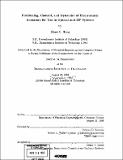Positioning, control, and dynamics of electrostatic actuators for use in optical and RF systems
Author(s)
Hung, Elmer S
DownloadFull printable version (9.264Mb)
Advisor
Stephen D. Senturia.
Terms of use
Metadata
Show full item recordAbstract
This thesis describes work on incorporating electrostatically-actuated microstructures for analog tuning and positioning applications within optical and RF systems. The work focuses on the design, simulation, and optimization of actuators which undergo large-amplitude motion, including ways to overcome the so-called pull-in instability which typically limits the stable travel distance of electrostatic actuators. These techniques are applied to the design and fabrication of: (1) the polychromator, a micromcchanical diffraction grating with a thonsand analog-positioned mirrors for use in a correlation spectroscopy system, and (2) a tunable capacitance device with a lithographically-programmable capacitance-voltage (C-V) characteristic for use in tunable RF oscillators. With the polychromator, 1 cm long electrostatic mirror actuators have achieved over 1. 75µm of displacement out of a 2[mu]m gap. Prototype tunable capacitors fabricated in a non-optimized process exhibit a 25% capacitance tuning range with a linear C-V characteristic and 35V actuation voltage. With an optimized process, simulations show that a 150% capacitive tuning range can ht: achieved with 3.3V actuation voltage. The integration of micromechanical devices into complex, mixed technology systems also requires methods for efficiently simulating the dynamics of micromcchanical devices. We present work on generating efficient reduced-order macromodels for simulating the dynamics of micromechanical devices by extracting global basis functions using information from a few runs of a computationally expensive finite element. model. Using a squeeze-film air-damped, electrostatically-actuated beam as an ex-ample, a macromodel with 2 pressure and 2 displacement basis functions achieves less than 2% error and a factor of 37 increase in efficiency compared to meshed simulation techniques along with good correspondence to experimental data.
Description
Thesis (Ph. D.)--Massachusetts Institute of Technology, Dept. of Electrical Engineering and Computer Science, 1998. Includes bibliographical references (leaves 99-107).
Date issued
1998Department
Massachusetts Institute of Technology. Department of Electrical Engineering and Computer SciencePublisher
Massachusetts Institute of Technology
Keywords
Electrical Engineering and Computer Science